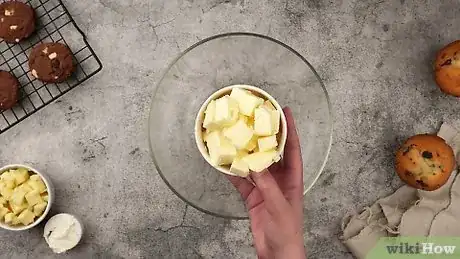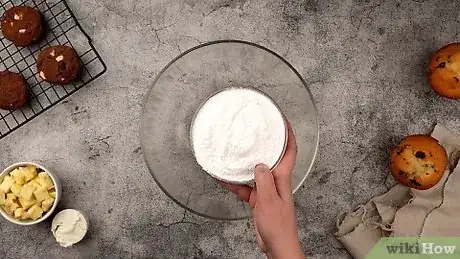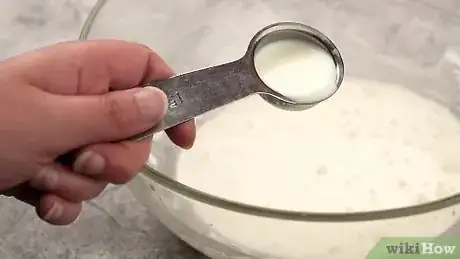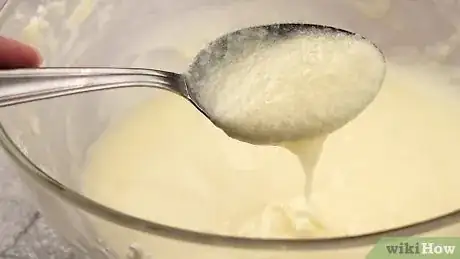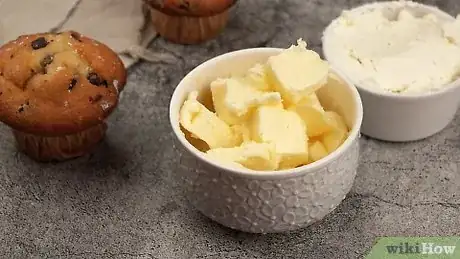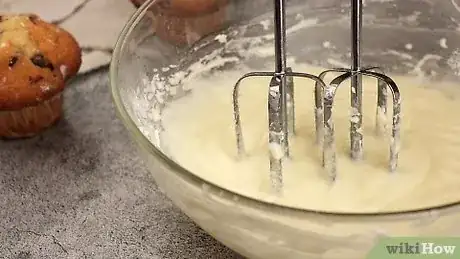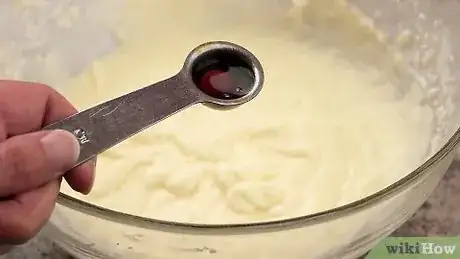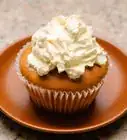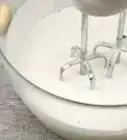This article was co-authored by JoAnna Minneci. JoAnna Minneci is a Professional Chef based in the Nashville, Tennessee area. With more than 18 years of experience, Chef JoAnna specializes in teaching others how to cook through private cooking lessons, team-building events, and wellness and nutrition classes. She has also appeared in numerous television shows on networks such as Bravo and Food Network. Chef JoAnna received Culinary Arts training from the Art Institute of California at Los Angeles. She is also certified in sanitation, nutrition, kitchen management, and cost control.
wikiHow marks an article as reader-approved once it receives enough positive feedback. This article received 41 testimonials and 87% of readers who voted found it helpful, earning it our reader-approved status.
This article has been viewed 1,366,441 times.
While chefs typically refer to sugar-based cake spreads as icing, and thicker cream- or butter-based spreads as frosting, both terms are widely used by non-professionals to refer to either type. The recipes below will allow you to make both varieties at home, but whatever you decide to call the results, they will be delicious. Experiment with different combinations of icing and cake, or read the beginning of each method for recommended pairings.
If you are looking for an icing that will allow you to create intricate designs on cakes, see these instructions for "royal icing" instead.
Ingredients
Buttercream icing:
- 1 cup (240mL) butter (or see instructions for vegan substitutions)
- 3 cups (720mL) powdered sugar
- 2 tablespoons (30mL) whipping cream
- 1 teaspoon (5mL) vanilla or almond extract
- Optional additional flavoring (see recipe for suggestions)
Sugar icing:
- ~2 cups (480 mL) powdered sugar
- ~4–12 tablespoons (60–180mL) milk or juice
- ~1 teaspoon (5mL) vanilla or almond extract
Cream cheese icing:
- 0.5 cups (120mL) butter or margarine
- 1 cup (240mL) cream cheese
- 2 cups (480mL) powdered sugar
- 1 teaspoon (5mL) vanilla extract
Steps
Making a Simple Buttercream Icing
-
1Whip this up quickly for a rich, sweet spread. This is the type of icing many people picture when they think of a classic birthday cake or cupcake topping. It can be made in less than twenty minutes, then spread over the top and sides of any cake to create a delicious, beautiful covering.
-
2Soften 1 cup (240mL) butter. The quickest way to soften butter is to place it in a microwave-safe dish and microwave it for 10–30 seconds. If you do not have a microwave, simply cut it into small pieces and leave it out on the counter. Either way, continue on once the butter is at room temperature and slightly soft, but not melted.
- If you will be serving the cake to vegans, replace the butter and whipped cream with a vegetable fat with rich flavor, such as cocoa butter or coconut fat. These tend to melt and solidify more quickly, which can make them difficult to work with.[1] An easier alternative is margarine, but consider improving on its flavor by adding a small amount of melted vegan chocolate, maple syrup, or other strong-flavored ingredient.
Advertisement -
3Mix the butter and sugar together. Put the softened butter in a large bowl and gradually add 3 cups (720mL) powdered sugar while mixing. This will go faster in an electric mixer, but can be done by hand within a few minutes as long as the butter is soft. If using an electric mixer, start at low speed and increase to medium once there is no dry sugar.[2]
-
4Add additional flavors (optional). You can skip this step entirely and still create a tasty, versatile buttercream icing. However, if you wish, you can alter it by stirring in a small amount of additional flavoring. Consider 1 teaspoon (5mL) lemon zest to pair with angel food cake, 1 ounce (30mL) melted, unsweetened chocolate for an even richer icing, or even a tablespoon (15mL) of instant coffee to give a chocolate cake a mocha flavor.
-
5Mix in the remaining ingredients. Add 2 tablespoons (30mL) whipping cream (or heavy cream) and 1 tsp. (5mL) vanilla or almond extract, then beat with a spoon or mixer until the color and texture are consistent. If it is thick but spreads evenly off a knife, it is ready to be spread onto the cake. Otherwise, troubleshoot with these tips:[3]
- If the icing is too soft, beat in 2 tbsp. powdered sugar thoroughly. Repeat until the frosting is thick enough to spread.
- If the icing is solid in places or cracks when you try to spread it, add 1 tbsp. water at a time, stirring thoroughly, until the frosting becomes soft enough to spread.
Making a Simple Sugar Icing
-
1Pour the powdered sugar into a large bowl. You may measure out 2 cups of powdered sugar, or simply pour the amount you think will suit your needs. It is extremely easy to adjust this recipe or make more, so do not feel pressured to keep your measurements exact.[4]
- Confectioner's sugar or icing sugar are simply other names for powdered sugar.[5]
-
2Pour in a small amount of milk or juice. Depending on the flavor you want to add, you may use milk, lemon juice, or any other juice.[6] Measure out 4 tablespoons of the liquid, or simply pour in a small amount, much less than the amount of sugar used. It's better to add too little and add more later than to add too much and have to add a lot more sugar than you intended to use.
- If your cake contains fruit, consider adding juice made from that type of fruit.
- Consider picking a juice based on the color you want your cake to be.
-
3Stir thoroughly with a spoon. Stir gently at first, or the sugar will get knocked over the edge of the bowl and make a mess. Stir until a paste is formed, or until all the liquid has been absorbed by the sugar.
-
4Stir in a little more liquid at a time until there is no dry sugar visible. Keep adding a little milk or juice at a time and stirring it in. When the mixture reaches an even consistency with no dry sugar on top of the paste, it is ready. Optionally, you may add a little more liquid to make the mixture thinner or to add more of the liquid's flavor. If the mixture becomes runny, however, stir in a little more sugar to compensate.
-
5Finish by mixing in a few drops of vanilla or almond extract. Carefully add a couple drops to your icing, or measure out 1 teaspoon (5mL). Stir it in thoroughly. You are now ready to spread your icing onto the cake with a knife or spoon!
- Add cocoa if you want chocolate frosting.[7]
Making Cream Cheese Icing
-
1Pair this with almost any cake. Cream cheese icing is especially popular on carrot cakes, but it also works well with chocolate, red velvet, or gingerbread cakes. Less sweet than a plain buttercream icing, it can be used on any cake or cookie to balance out the sugary taste with its own, rich flavor.
-
2Soften the butter and cream cheese. Take 0.5 cups (120mL) butter or margarine and 1 cup (240mL) cream cheese. Soften them in the microwave or simply by cutting them into small chunks and leaving them at room temperature. Continue once the ingredients are soft but not melted.
- You may replace half of the cream cheese with an equal amount butter if you prefer a taste closer to a normal buttercream frosting with some cream cheese flavor, rather than a mostly cream cheese taste.
- Full fat cream cheese will create a good textured frosting. Low fat cream cheese might make the frosting runny.
-
3Mix together the cream cheese and butter thoroughly. Use an electric mixer if possible, as this may become tedious and tiring if you do it by hand. Mix until there are no lumps and the entire mixture has the same color and texture.
-
4Stir in the powdered sugar. After the butter and cream cheese are nicely mixed, gradually add 2 cups (480mL) powdered sugar in 1/2 cup (120mL) increments, mixing thoroughly.
-
5Beat until light and fluffy. Continue to mix the icing until it is light and fluffy. If you are not sure whether it's fluffy enough, stop; it's better to end up with slightly thick frosting than to beat it too much and make it runny.
- If your frosting became runny, you can make it thicker by adding more cream cheese, mixing in a little more powdered sugar, or by trying out another thickening method.
-
6Finish by stirring in the vanilla extract. Add 1 tsp. (5mL) vanilla extract to the icing and mix it in briefly. It should no longer be visible, but there is no need to beat it for longer than thirty seconds. Your icing is now ready to spread onto your cake.
Community Q&A
-
QuestionIs icing better with butter or shortening?
 JoAnna MinneciJoAnna Minneci is a Professional Chef based in the Nashville, Tennessee area. With more than 18 years of experience, Chef JoAnna specializes in teaching others how to cook through private cooking lessons, team-building events, and wellness and nutrition classes. She has also appeared in numerous television shows on networks such as Bravo and Food Network. Chef JoAnna received Culinary Arts training from the Art Institute of California at Los Angeles. She is also certified in sanitation, nutrition, kitchen management, and cost control.
JoAnna MinneciJoAnna Minneci is a Professional Chef based in the Nashville, Tennessee area. With more than 18 years of experience, Chef JoAnna specializes in teaching others how to cook through private cooking lessons, team-building events, and wellness and nutrition classes. She has also appeared in numerous television shows on networks such as Bravo and Food Network. Chef JoAnna received Culinary Arts training from the Art Institute of California at Los Angeles. She is also certified in sanitation, nutrition, kitchen management, and cost control.
Professional Chef Butter is better for flavor, while shortening is better for resiliency. You can also use a combination of those two to get some kind of balance.
Butter is better for flavor, while shortening is better for resiliency. You can also use a combination of those two to get some kind of balance. -
QuestionCan I use any type of milk for icing?
 QamarTop AnswererYes, any type of milk will work.
QamarTop AnswererYes, any type of milk will work. -
QuestionWhat is fondant icing?
 Community AnswerIt is a type of icing that is used for cakes. It is made from sugar, water, gelatin and glycerol.
Community AnswerIt is a type of icing that is used for cakes. It is made from sugar, water, gelatin and glycerol.
Warnings
- Do not leave extra icing out at room temperature. Store any leftover icing in a sealed container in the fridge or other cold, dark location to keep it a consistent texture.⧼thumbs_response⧽
Things You'll Need
- Large bowl
- Large mixing spoon
- Electric mixer (recommended for cream cheese frosting especially)
References
- ↑ http://www.veganbaking.net/recipes/cake-decorating/frostings
- ↑ http://www.foodnetwork.com/recipes/quick-vanilla-buttercream-frosting-recipe.html
- ↑ http://cake-decorating.lovetoknow.com/Wilton_Buttercream_Frosting
- ↑ https://www.thekitchn.com/simple-solutions-how-to-make-a-94001
- ↑ JoAnna Minneci. Professional Chef. Expert Interview. 23 December 2021.
- ↑ JoAnna Minneci. Professional Chef. Expert Interview. 23 December 2021.
- ↑ JoAnna Minneci. Professional Chef. Expert Interview. 23 December 2021.
About This Article
One way to make cake icing is by preparing a buttercream frosting, which starts by placing 1 cup of butter into the microwave for 10-30 seconds to soften it. Then, gradually mix the softened butter with 3 cups of powdered sugar, by hand or in an electric mixer on low speed. Once the butter and sugar are combined, add 2 tablespoons of whipping cream or heavy cream, and 1 teaspoon of vanilla or almond extract. Beat the mixture until it’s thick enough to apply with a knife, and spread it over the cake! For more tips, including how to make a simple sugar or cream cheese icing, read on!

